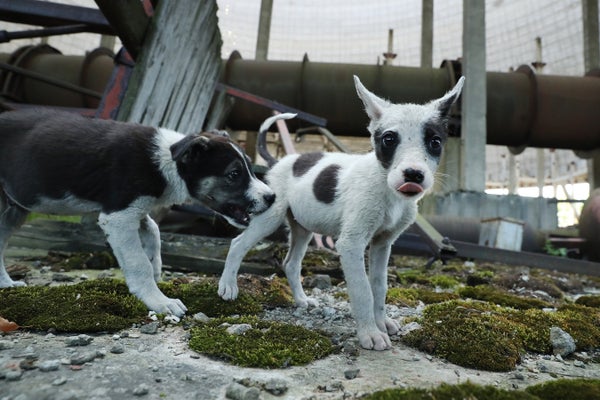In the early hours of 26 April 1986, two explosions rocked the nuclear power plant near the Ukrainian city of Chernobyl, then part of the Soviet Union. The accident at reactor four spewed radioactive material into the air, leading Soviet authorities to evacuate thousands of people from the surrounding area. Homes were left behind — and, in many cases, pets.
In the days after the accident, response crews sought out abandoned and stray dogs, with the goal of killing them to stop the spread of radioactivity. Yet some seem to have survived.
In the first genetic study of any large mammal in the area around Chernobyl, DNA collected from feral dogs living near the power plant today reveals that they are the descendants of dogs that were either present at the time of the accident or that settled in the area shortly afterwards1. The study, published on 3 March in Science Advances, is the first step in a larger project aimed at determining how the dogs have adapted to survive in one of the most radioactive places on Earth. Researchers hope to use the knowledge gained to better understand the effects of long-term radiation exposure on human genetics and health.
On supporting science journalism
If you're enjoying this article, consider supporting our award-winning journalism by subscribing. By purchasing a subscription you are helping to ensure the future of impactful stories about the discoveries and ideas shaping our world today.
“We have so much to learn from these animals,” says Elaine Ostrander, a geneticist at the US National Institutes of Health in Bethesda, Maryland, and co-author of the study. “This is a golden opportunity to see what happens when generations of large mammals live in a hostile environment.”
The aftermath
The immediate impacts of the accident at Chernobyl were obvious: around 30 people who worked at the power plant and fire fighters who attended after the disaster died of radiation poisoning within a few months of the catastrophe, according to the World Health Organization. And in the surrounding areas, pine trees withered and many insect species vanished, unable to survive in the radioactive soil.
What is less clear is how low levels of lingering radioactive material from the disaster affect the plants and animals around Chernobyl today. A handful of studies have reported unusually high genetic mutation rates in barn swallows2 and fruit flies3 in the vicinity of the reactor, which is now entombed in a steel and concrete sarcophagus.
However, the health effects of low-levels of radiation are still hotly debated. This matters because people risk exposure to low doses of radiation in all sorts of contexts, including through certain medical scans or while working at nuclear power plants, says David Brenner, a radiation biophysicist at Columbia University in New York City who was not involved in the research. “It’s really difficult to figure out the effects” of this type of exposure, he adds, “but pretty important that we do so”.
This was a motivating factor for co-author Timothy Mousseau, an evolutionary ecologist at the University of South Carolina in Columbia. In 2017, Mousseau joined a volunteer mission to provide veterinary care to the hundreds of stray dogs living in the exclusion zone, a 2,600-square-kilometre area around the power plant to which Ukrainian officials restrict access for safety reasons.
Over the course of three years of trips to the area, Mousseau and his colleagues collected blood samples from around 300 dogs living at the power plant and around the mostly deserted city of Chernobyl after volunteers had sedated the animals with tranquilizer darts.
DNA analysis of the canines revealed that they were not newcomers to the area. By comparing the dogs’ genetic profiles to those of other free-roaming dogs in Eastern Europe, the team found that the canines in the vicinity of the power plant — some of which are related to shepherd breeds — have been isolated from other dog populations for decades. And the researchers learnt that, despite Soviet concerns during the 1980s that the dogs would migrate and spread radioactive material, most of these animals hadn’t moved far: those living closest to the power plant are genetically distinct from their kin living just a few kilometres away.
A radioactive legacy
The dogs’ continued presence in the area shows that they were able to survive and breed, even while living near the reactor, “which is remarkable”, says Ostrander. The 1986 accident deposited the deadly radioactive isotope cesium-137 at levels 10 to 400 times higher near the power plant than in the city of Chernobyl, just 15 kilometres away.
The canine DNA samples “are incredibly valuable” because dogs tend to share many of the same spaces and diets as humans, Ostrander says. “We’ve never had an opportunity to do this work in an animal that reflects us as well as dogs.”
But teasing out which genetic changes in the dogs are caused by radiation and which are caused by other factors — such as inbreeding or non-radioactive pollutants — won’t be easy, Brenner cautions. The team acknowledges these challenges, but the researchers argue that their detailed knowledge of these dogs’ ancestry, as well as knowledge of the levels of radiation different dogs were historically exposed to, “provides an ideal focus group for our future studies”.
In the meantime, Mousseau is planning another sampling trip in June. The ongoing war in Ukraine hasn’t stopped the group’s research. But with fewer tourists visiting and leaving food scraps, Chernobyl’s dogs are struggling to get by. So the team is working with a non-governmental organization to provide food to the strays, safeguarding the survival of Chernobyl’s dogs — and their radioactive legacy — in the lean times ahead.
This article is reproduced with permission and was first published on March 3, 2023.
